- News & information
- About
- History
- George V. Voinovich
- George V. Voinovich Collection
- Calendar
- How to Find Us
- News
- Archives
- Photojournalism Fellowship Project
- Photo Essays
- Current Fellow
- Previous Fellows
- Reports and Publications
- Archives
- Students
- Prospective
- Center for Entrepreneurship
- Environmental Studies
- HTC/Voinovich School Scholars
- Master of Public Administration
- Current
- HTC/Voinovich School Scholars
- Center for Entrepreneurship
- Environmental Studies
- Master of Public Administration
- Alumni
- Contact
- School Leadership
- Strategic Partners Alliance
- Ohio University Public Affairs Advisory Committee
- Ohio University Public Affairs Advisory Committee
- Faculty and Fellows
- Faculty
- Visiting Professors
- Voinovich Fellows
- Professional Staff
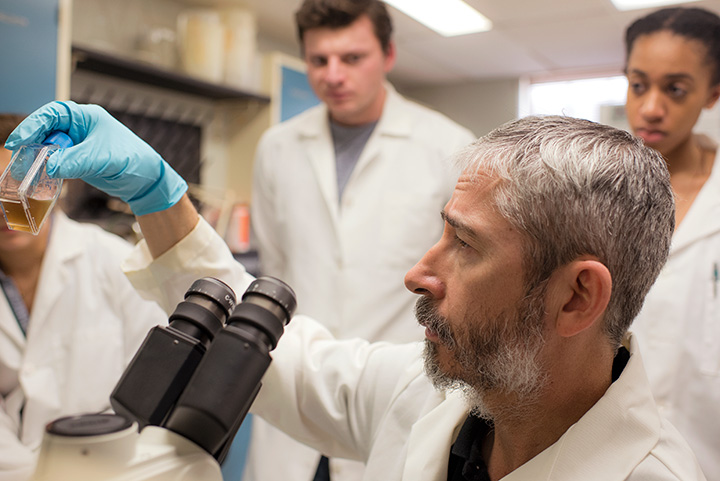
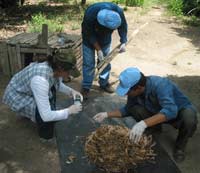
1. Improving safety of the blood supply
The safety of the blood supply depends on the quality of the processes used in its processing, including screening for disease markers. However, lack of financial resources, weak enforcement of regulations and oversight, and lack of training create risks for the transmission of diseases through blood transfusions. At present, our laboratory in Ecuador serves as the organizing center for the “External Performance Evaluation Program in serological screening” for the blood banks of Ecuador. This program was initiated in 2003 and is actively catalyzing the implementation of better procedures and training within the blood services in Ecuador. These efforts aim to determine the effectiveness of the blood screening procedures in the country and recommend interventions to improve the safety of the blood supply.
2. Serological and epidemiological studies in Chagas disease endemic areas of Ecuador and in the United States.
Research into Chagas disease in the blood supply led us to inquire about the status of the disease in Ecuador. Since 1997 we have been investigating the status of Chagas disease in Ecuador. The results of this ongoing investigation reveal that Chagas disease affects a large number of people in Ecuador. One common feature present in all areas studied has been the pervasive lack of knowledge about the disease, how it is transmitted, how to prevent it or treat it, exhibited by the population in general and by the health care community in particular. As more samples are collected and analyzed, the epidemiological map of Chagas disease in Ecuador is emerging.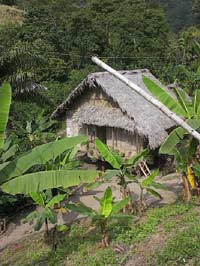
3. Biological and physiological studies of Chagas disease vectors from Ecuador
The countries of the Southern Cone of South America have achieved a great deal of success in their efforts to eliminate vectorial transmission of Chagas disease. This has been possible because research demonstrated that the main vector in this region, namely, Triatoma infestans , was found exclusively in domiciles and in the peridomiciles. Therefore, a straightforward intervention approach using insecticides was effective in controlling this species. The situation in northern South America is quite different. Just in Ecuador, 15 different species of Triatomines have been reported and there is little or no information related to their vectorial potential, their habitat or their behavior.Since the serological studies pinpointed the areas of active transmission, considerable effort is now being placed in the study of the Triatomines present in Ecuador. These efforts have led to the capture of thousands of Triatomines belonging mainly to Rhodnius ecuadoriensis, Triatoma carrioni, Panstrongylus rufotuberculatus and Pastrongilus howardi. The captured individuals have been transported to the insectary in our laboratory in Quito, where colonies have been established for the study of natural infection with T. cruzi and T. rangeli , and different aspects of the physiology and life cycle of these species under laboratory conditions.
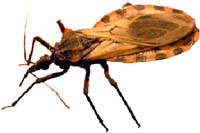
4. Ecology of mammalian T. cruzi reservoirs and characterization of T. cruzi strains present in Ecuador and the USA.
Chagas disease is considered a zoonotic disease. It is believed that the sylvatic cycle of T. cruzi existed long before humans colonized the Americas. As a result, the parasite is found in many reservoir species. These include rats, mice, opossums, raccoons, armadillos, monkeys, etc. Our group has been conducting yearly collections of synanthropic mammals and performing serological testing on dogs in Ecuador since 2001. In addition, in collaboration with colleagues from Clemson University, South Carolina, and Berry College and Georgia Southern University in Georgia, we have been examining the natural infection of these animals in the United States using prospective and retrospective analysis of freshly collected and archival tissue samples, respectively.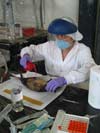
5. Dynamics of parasite in vivo infection and its correlation with expression of cytokines and chemokines in tissues from experimentally Trypanosoma cruzi infected mice.
The aim of this project is the characterization of the basic immunopathological processes that are observed in experimental T. cruzi infections in mice.6. Development of research infrastructure and improvement of research training in Ecuador
One of the major obstacles to conduct meaningful research in Ecuador was the lack of infrastructure. Cooperation between Catholic University of Ecuador and Ohio University led to the creation of the Infectious Disease Research Laboratory (IDRL) in the campus of Catholic University in Quito. Our laboratory has a group of dedicated and well trained laboratory technicians and serves as the base of operations for all of the activities of our research group in the country.
7. Healthy Living Initiative: Long term Chagas disease Control via social development
The “Healthy Living” project is a long-term initiative that aims to support socioeconomic development of rural communities as the main tool for the control of Chagas disease in the province of Loja in southern Ecuador.
With a holistic approach, this public health strategy looks to prevent the transmission of Chagas and other diseases “associated with poverty” by facilitating participatory processes of human development that are sustainable and sustained by the people involved. Learn more about it here .
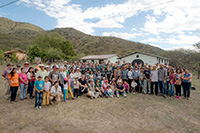
8 . Other projects
Other ongoing initiatives include sociological, clinical and anthropometric studies in rural areas of Ecuador, biological control of Triatomines, genetic characterization of T. cruzi and T. rangeli , development of video and graphic tools for community education, training of Ecuadorian health care workers, and integration of all the components mentioned above in a Geographical Information System, among others.College of Osteopathic Medicine
Irvine Hall, Athens, Ohio 45701
740-593-2530 740-597-2778 fax
Contact Information:
(740) 593–9381 | Building 21, The Ridges
Ohio University Contact Information:
Ohio University | Athens OH 45701 | 740.593.1000 ADA Compliance | © 2018 Ohio University . All rights reserved.


